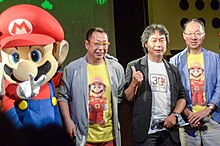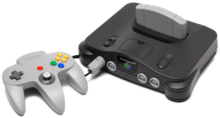User:DecafPotato/drafts/Super Mario
| Super Mario | |
|---|---|
 Official logo since 2011 | |
| Genre(s) | Platformer |
| Developer(s) |
|
| Publisher(s) | Nintendo |
| Creator(s) | Shigeru Miyamoto |
| Composer(s) | |
| Platform(s) | |
| First release | Super Mario Bros. September 13, 1985 |
| Latest release | Super Mario Bros. Wonder October 20, 2023 |
| Parent series | Mario |
| Spin-offs | |
Super Mario[a] is a series of platform video games created by Nintendo. The central series of the larger Mario franchise, at least one Super Mario game has been released for every Nintendo video game console since its inception. The series stars the plumber Mario, who typically serves as the games' player character. Games are primarily set in the fictional Mushroom Kingdom, and most games see Mario rescuing Mushroom Kingdom Princess Peach from Bowser, a turtle-like creature called a Koopa. Mario is occasionally joined by his brother Luigi, along with other Mario franchise characters.
The first Super Mario game was Super Mario Bros., which released in 1985 for the Nintendo Entertainment System. Directed and designed primarily by Shigeru Miyamoto and Takashi Tezuka of Nintendo EAD, it established the gameplay that would become typical for future games, including side-scrolling, power-ups, and enemies. Super Mario Bros. received multiple sequels, and Super Mario 64 (1996) was the series' first game played in 3D, and featured more nonlinear gameplay and design compared to its predecessors. After a hiatus, New Super Mario Bros. (2006) marked the return of linear 2D games, causing the series to shift towards increasingly linear design in both 2D and 3D. Following internal reorganization in 2015, Nintendo EPD succeeded Nintendo EAD as the developer of the Super Mario series. The open-ended and exploration-based gameplay of Super Mario 64 and Sunshine (2002) returned in Super Mario Odyssey, released in 2017 for the Nintendo Switch.
History and development[edit]
1980–1985: Conception and first game[edit]
In 1980, Nintendo released Radar Scope, their first arcade video game,[1] which was a commercial failure.[2][3]: 94, 103 Nintendo president Hiroshi Yamauchi appointed Shigeru Miyamoto to repurpose unused Radar Scope arcade cabinets into a new game.[1][2] While Miyamoto wanted the game to star Popeye characters,[4] negotiations between Nintendo and Popeye owner King Features fell through, and the game required reworking.[3]: 47 Three new characters were created for the game instead: Jumpman, Lady, and Donkey Kong.[4][5] Titled Donkey Kong, the game was released in arcades in 1981.[6] Lady was later renamed to Pauline,[7] and Jumpman was renamed to Mario.[3]: 109 Miyamoto created Mario's brother Luigi using palette swap of Mario's sprite.[2] Mario and Luigi starred together in the 1983 arcade game Mario Bros.[8] The gameplay of Donkey Kong and Mario Bros., centered around the act of jumping to dodge obstacles, caused the games to be considered landmark titles in the platformer genre of games.[9][2]

Following a 1983 crash in the video game market,[10] Nintendo released the Famicom / Nintendo Entertainment System (NES) in Japan in July 1983, and the console released outside of Japan in 1985.[2][11] Yamauchi granted Miyamoto his own development team, Nintendo R&D4 (later Nintendo EAD), which aimed to develop games for the console before its introduction in North America.[2] Prototyping for a new Mario game began in December 1984, directed by Miyamoto and programmed by SRD.[12]: 1 Led by Miyamoto and Takashi Tezuka, Super Mario Bros. was released on September 13, 1985, for the NES.[10][13] The game's soundtrack was composed by Koji Kondo.[14] Credited with helping to revive the video game industry following the crash of 1983[2][10] and largely contributing to the success of the NES in North America, Super Mario Bros. went on to sell over forty million units, making it one of the best-selling games of all time.[2]
1986–1995: 2D sequels[edit]
After Super Mario Bros. released, development began for a sequel to be released on the Famicom Disk System.[2] In 1986, Super Mario Bros. 2 released in Japan.[15] Super Mario Bros. 2 reused many assets from the first game, but was much more difficult, with some levels being taken from Vs. Super Mario Bros., an arcade adaptation of the first game.[2] Fearing that the game would be too difficult for Western audiences, the game did not release outside of Japan.[2][16] Instead, Nintendo chose to adapt Yume Kōjō: Doki Doki Panic, replacing its characters with Mario characters.[10] Doki Doki Panic was created out of a prototype for a vertically scrolling two-player cooperative game. It later introduced more side-scrolling elements to make it more like Super Mario Bros., however it starred characters from the Yume Kōjō expo as a tie-in.[17] The version of Doki Doki Panic adapted with Mario characters was released outside of Japan in October 1988 as Super Mario Bros. 2,[2] directed by Kensuke Tanabe.[17] The version of Super Mario Bros. 2 released outside of Japan was later released in Japan as Super Mario USA,[16] and the version released in Japan was later released internationally as Super Mario Bros.: The Lost Levels.[10] The next game, Super Mario Bros. 3, was directed and designed by Miyamoto and Tezuka, while Kondo returned as composer.[18] Released in Japan 1988 and in the United States two years later, the game was a critical and commercial success.[10]
1996–2005: Transition to 3D and nonlinear design[edit]

2006–-2016: 2D revival and increased linearity[edit]
2017–present: Return of open-ended exploration[edit]
Characters and story[edit]
Gameplay[edit]
Music[edit]
Reception and influence[edit]
Notes[edit]
References[edit]
- ^ a b Parish, Jeremy (January 20, 2014). "35 Years Ago, Nintendo's First Brush With Video Disaster". USgamer. Archived from the original on May 2, 2019. Retrieved February 3, 2023.
- ^ a b c d e f g h i j k l McLaughlin, Rus (September 14, 2010). "IGN Presents: The History of Super Mario Bros". IGN. Retrieved February 3, 2023.
- ^ a b c Sheff, David (1993). Game over: how Nintendo zapped an American industry, captured your dollars, and enslaved your children (1st ed.). New York: Random House. ISBN 0-679-40469-4. OCLC 26214063.
- ^ a b Thomas, Lucas M. (December 2, 2006). "Donkey Kong Virtual Console Review". IGN. Retrieved February 3, 2023.
- ^ Hernandez, Pedro (May 23, 2010). "Nintendo History 101: Donkey Kong vs. King Kong - Feature". Nintendo World Report. Retrieved February 3, 2023.
- ^ Latson, Jennifer (June 2, 2015). "How Donkey Kong and Mario Changed the World". Time. Retrieved February 3, 2023.
- ^ Knorr, Alyse (November 14, 2018). "How Princess Peach's Story Draws On 2000 Years Of Women In Peril". Kotaku. Retrieved February 3, 2023.
- ^ Knezevic, Kevin. "Nintendo Switch Adds First Classic Nintendo Game Today". GameSpot. Retrieved February 3, 2023.
- ^ "A generation of games". The Times. August 12, 2003. ISSN 0140-0460. Retrieved February 3, 2023.
- ^ a b c d e f Shea, Brian (March 10, 2022). "Making Mario: A Look Back At The First 30 Years". Game Informer. Retrieved February 3, 2023.
- ^ Welsh, Oli (February 24, 2017). "A complete history of Nintendo console launches". Eurogamer. Retrieved February 3, 2023.
- ^ Miyamoto, Shigeru; Kondo, Koji; Tezuka, Takashi; Nakago, Toshihiko (September 13, 2010). "Iwata Asks: Super Mario 25th Anniversary". Iwata Asks (Interview). Vol. 5. Interviewed by Iwata, Satoru. Nintendo. Archived from the original on August 26, 2022. Retrieved February 9, 2023.
- ^ Craddock, Ryan (September 13, 2020). "Today's The Big Day - Happy 35th Anniversary, Mario!". Nintendo Life. Retrieved February 9, 2023.
- ^ Riendeau, Danielle (December 15, 2014). "The man behind Nintendo's musical masterpieces". Polygon. Retrieved June 23, 2023.
- ^ Walker, Ian (October 9, 2020). "America Got The Better Super Mario Bros. 2". Kotaku. Retrieved June 23, 2023.
- ^ a b Van Duyn, Marcel (May 25, 2007). "Review: Super Mario Bros. 2 (Wii Virtual Console / NES)". Nintendo Life. Retrieved June 23, 2023.
- ^ a b Kohler, Chris. "The Secret History of Super Mario Bros. 2". Wired. ISSN 1059-1028. Retrieved June 23, 2023.
- ^ Knorr, Alyse (April 27, 2016). "The Making (And Legacy) Of Super Mario Bros. 3". Kotaku. Retrieved June 23, 2023.
